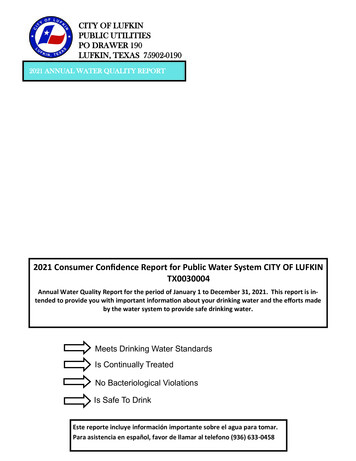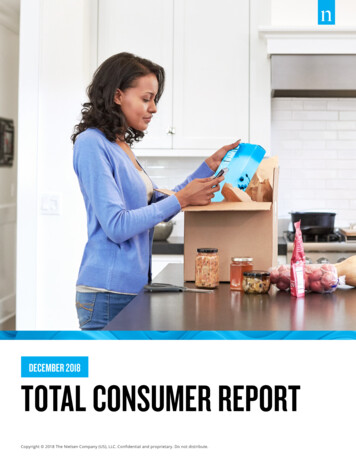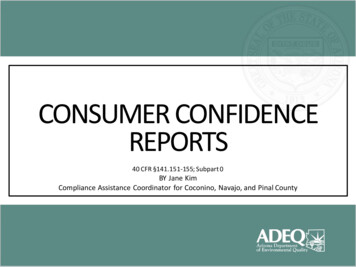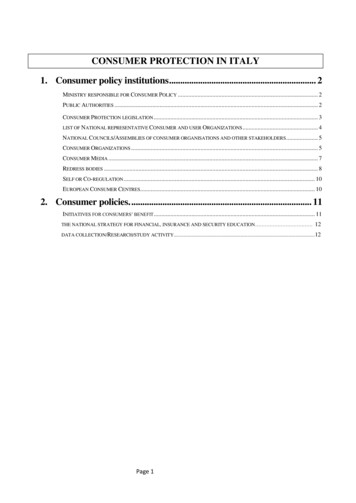
Transcription
CITY OF LUFKINPUBLIC UTILITIESPO DRAWER 190LUFKIN, TEXAS 75902-01902021 ANNUAL WATER QUALITY REPORT20192021 Consumer Confidence Report for Public Water System CITY OF LUFKINTX0030004Annual Water Quality Report for the period of January 1 to December 31, 2021. This report is intended to provide you with important information about your drinking water and the efforts madeby the water system to provide safe drinking water.Meets Drinking Water StandardsIs Continually TreatedNo Bacteriological ViolationsIs Safe To DrinkEste reporte incluye información importante sobre el agua para tomar.Para asistencia en español, favor de llamar al telefono (936) 633-0458
City of Lufkin 2021 Annual Drinking Water Quality Report(Consumer Confidence Report for the Period of January 1 to December 31, 2021)www.cityoflufkin.comWe invite you to visit with us @Lufkin City Hall300 E. ShepherdLufkin, TX. 75902City Council meets every First & Third Tuesday of each month @ 5pm in theCouncil Chambers.For more information, please call (936)633-0243.CONTACT USAlbert Duffield Jr.—Public Utility Director (936)633-0211CITY OF LUFKIN provides ground water from the CorrizoAquifer located in Angelina County.Drinking water, including bottled water, may reasonably be expected tocontain at least small amounts of some contaminants. The presence ofcontaminants does not necessarily indicate that water poses a healthrisk. More information about contaminants and potential healtheffects can be obtained by calling the EPAs Safe Drinking Water Hotlineat (800) 426-4791. Microbial contaminants, such as viruses and bacteria, which maycome from sewage treatment plants, septic systems, agriculturallivestock operations, and wildlife. Inorganic contaminants, such as salts and metals, which can benaturally-occurring or result from urban storm water runoff,industrial or domestic wastewater discharges, oil and gasproduction, mining, or farming. Pesticides and herbicides, which may come from a variety ofsources such as agriculture, urban storm water runoff, andresidential uses. Organic chemical contaminants, including synthetic and volatileorganic chemicals, which are by-products of industrial processesand petroleum production, and can also come from gas stations,urban storm water runoff, and septic systems. Radioactive contaminants, which can be naturally-occurring or bethe result of oil and gas production and mining activities.(936)633-0288Jarod Murphy—Water Distribution(936)633-0230Sandra Silva—Utility Collections(936)633-0255For more information regarding this report, please contact, Phillip BryanWater Plant Superintendent City of Lufkin Water Plant (936)633 -0288The sources of drinking water (both tap and bottled water) includerivers, lakes, streams, ponds, reservoirs, springs, and wells. As watertravels over the surface of the land or through the ground, it dissolvesnaturally-occurring minerals and, in some cases, radioactive material,and can pickup substances resulting from the presence of animals orfrom human activity.Contaminants that may be present in source water include:Phillip Bryan—Water ProductionIn order to ensure that tap water is safe to drink, EPA prescribesregulations which limit the amount of certain contaminants in waterprovided by public water systems. FDA regulations establish limits forcontaminants in bottled water which must provide the same protectionfor public health.Contaminants may be found in drinking water that may cause taste,color, or odor problems. These types of problems are not necessarilycauses for health concerns. For more information on taste, odor, orcolor of drinking water, please contact the system’s business office.You may be more vulnerable than the general population to certainmicrobial contaminants, such as Cryptosporidium, in drinking water.Infants, some elderly, or immunocompromised person such as thoseundergoing chemotherapy for cancer; persons who have undergoneorgan transplants; those who are undergoing treatment with steroids;and people with HIV/AIDS or other immune system disorders, can beparticularly at risk from infections. You should seek advice aboutdrinking water from your physician or health care providers. Additionalguidelines on appropriate means to lessen the risk of infection byCryptosporidium are available from the Safe Drinking Water Hotline(800-426-4791).If present, elevated levels of lead can cause serious health problems,especially for pregnant women and young children. Lead in drinkingwater is primarily from materials and components associated withservice lines and home plumbing. We are responsible for providinghigh quality drinking water, but we cannot control the variety ofmaterials used in plumbing components. When your water has beensitting for several hours, you can minimize the potential for lead exposure by flushing your tap for 30 seconds to 2 minutes before usingwater for drinking or cooking. If you are concerned about lead in yourwater, you may wish to have your water tested. Information on lead indrinking water, testing methods, and steps you can take to minimizeexposure is available from the Safe Drinking Water Hotline or athttp://www.epa.gov/safewater/lead.
City of Lufkin 2021 Annual Drinking Water Quality Report(Consumer Confidence Report for the Period of January 1 to December 31, 2021)CONSERVE OUR WATER / TAKE CARE OF LUFKINCONSERVATION TIPSNext to air, water is the most important element for the preservation of life. Using water more efficiently will not only savemoney but, more importantly, will protect the quality of life of current and future Texans. Texas is subject to frequentdroughts and population increase, therefore, a few changes in water use habits can make a huge difference in water conservation.1.Check for water leaks in pipes, faucets, couplings inside and outside the home. Leaks outside the home are easier to ignore but are more wasteful than inside leaks especially when they are on the main water line.2.Check your toilet for leaks by putting a few drops of food coloring in your toilet tank. If, without flushing, the coloring begins to appear in the bowl half to one hour later, your toilet is leaking.3.Stop using your toilet as a wastebasket and ashtray. Only put toilet paper because other products may clog the pipes andtakes more water to clear the bowl.4.Keep a pitcher of cold water in the refrigerator rather than letting the faucet run until the water is cool.5.Hand washing dishes takes more time than using a dishwasher. Let your dishwasher do the work and you will save almost10 days a year! You’ll also save money and water! If washing dishes by hand, use a basin of soapy water or plug the sink.6.Use the dishwasher efficiently. Only run it when you have a full load. Scrape dirty dishes and cookware rather thanrinsing them. Use the “light wash” feature when possible.7.Showering accounts for nearly 17% of indoor water use. Reduce this by taking shorter showers. Get a shower timer foryour kids and make it into a game.8.Turn off the tap when shaving or brushing your teeth and save up to 2,400 gallons of water a year. This is an easy one forboth kids and adults to try.9.Washing only full loads of laundry can save an average household more than 3,400 gallons of water each year. As abonus, you can also save energy by using cold water when possible.10. Sweep driveways and sidewalks as opposed to hosing them off.11. If you have a pool, use a cover to reduce evaporation.12. Wash your car with water from a bucket or use a commercial car wash that recycles water.13. When mowing your lawn, set the mower blades to 2-3 inches high. Longer grass shades the soil improving moister retention, has more leaf surface to take in sunlight allowing it to grow thicker and develop a deeper root system. This helpsgrass survive drought, tolerate insect damage, and fend off disease.14. Apply mulch around shrubs and flower beds to reduce evaporation, promote plant growth and control weeds.15. Prevent evaporation of water by watering, when necessary, the lawn early in the morning and never on a windy day.There is a free tool to help you save money on your water billAquaHawk, a billing Alert System, is a service for the City of Lufkin customers that will enable you to efficiently manage yourwater usage and lower your monthly bills. Customers who are interested in the service must register to create a new accountto receive notifications.After you register, AquaHawk will analyze your water usage with the customer portal and can notify you of the following afteryou set your alert thresholds. AquaHawk allows you to specify an amount of water (gallons) or an estimated bill amount(dollars) that you don’t want to exceed. If your water consumption or bill amount has exceeded the threshold value, AguaHawkwill send you a notification. You will need service address and account number, which is on the water bill, to create your account.
City of Lufkin 2021 Annual Drinking Water Quality Report(Consumer Confidence Report for the Period of January 1 to December 31, 2021)www.cityoflufkin.comINFORMATION ABOUT SOURCE WATERTCEQ completed an assessment of your source water, and results indicate that some of our sources are susceptible to certain contaminants. The sampling requirementsfor your water system is based on this susceptibility and previous sampling data. Any detections of these contaminants will be found in this Consumer Confidence Report. For more information on source water assessments and protection efforts at our system contact Phillip Bryan @ (936)633-0288.COLIFORM BACTERIAMaximum Contaminant LevelTotal ColiformMaximumContaminant LevelHighest No.of PositiveFecal Coliform orE.Coli MaximumContaminant LevelTotal No. of Positive E.Coli or Fecal ColiformSamplesViolation00000NLikely Source of ContaminationNaturally present in theenvironment.COPPERLead andCopperDateSampledMCLGAction Level(AL)90thPercentile# of Sites NLikely Source ofContaminationErosion of natural deposits; Leaching from woodpreservatives; Corrosion of household plumbing systems.RESIDUAL DISINFECTION LEVELDisinfectantResidualYearAverageLevelRange ofLevels DetectedMRDLMRDLGUnit ofMeasureViolation(Y/N)Source in Drinking WaterChlorine20212.671.1-3.944ppmNWater additive used to control microbesDefinitions and Abbreviations:The following tables contain scientific terms and measures, some of which may require explanation.Action Level:AVG:Level 1 Assessment:Level 2 Assessment:Maximum Contaminant Level or MCL:Maximum Contaminant Level Goal or MCLG:Maximum Residual Disinfectant Level or MRDL:Maximum Residual Disinfectant Level ment Technique or TT:The concentration of a contaminant which, if exceeded, triggers treatment or other requirements whicha water system must follow.Regulatory compliance with some MCLs are based on running annual average of monthly samples.A Level 1 Assessment is a study of the water system to identify potential problems and determine (ifpossible) why total coliform bacteria have been found in our water system.A Level 2 Assessment is a very detailed study of the water system to identify potential problems anddetermine (if possible) why an E.coli MCL violation has occurred and/or why total coliform bacteriahave been found in our water system on multiple occasions.The highest level of a contaminant that is allowed in drinking water. MCLs are set as close to the MCLGsare feasible using the best available treatment technology.The level of a contaminant in drinking water below which there is no known or expected risk to health.MCLGs allow for a margin of safety.The highest level of a disinfectant allowed in drinking water. There is convincing evidence that additionof a disinfectant is necessary for control of microbial contaminants.The level of a drinking water disinfectant below which there is no known or expectedrisk to health. MRDLGs do not reflect the benefits of the use of disinfectants toontrol microbial contaminants .million fibers per liter (a measure of asbestos)millirems per year (a measure of radiation absorbed by the body)not applicablenephelometric turbidity units (a measure of turbidity).picocuries per liter (a measure of radioactivity).micrograms per liter or parts per billionmilligrams per liter or parts per millionparts per quadrillion, or pictograms per liter (pg/L)parts per trillion, or nanograms per liter (ng/L)A required process intended to reduce the level of a contaminant in drinking water.
City of Lufkin 2021 Annual Drinking Water Quality Report(Consumer Confidence Report for the Period of January 1 to December 31, 2021)www.cityoflufkin.comRegulated ContaminantsDisinfectants andDisinfection By-ProductsHaloacetic Acid (HAAS)CollectionDateHighestLevelDetectedRange 0No goal forthe total60ppbNLikely Source ofContaminationBy-product of drinking waterdisinfection*The value in the Highest Level Or Average Detected column is the highest average of all HAA5 sample results collected at a location over a yearTotal Trihalomethanes(TTHM)20215941.1-73.8No goal forthe total80ppbNBy-product of drinking waterdisinfection*The value in the Highest Level or Average Detected column is the highest average of all TTHM sample results collected at a location over a yearInorganic e ofIndividualSamplesMCLGMCLUnitsViolationLikely Source mNDischarge of drilling wastes: Dischargefrom metal refineries; Erosion of mNErosion of natural deposits; Water additive which promotes strong teeth; Discharge from fertilizer and aluminumfactories.Nitrate [measured as Nitrogen]20210.02950.0231-0.02951010ppmNRunoff from fertilizer use; Leaching fromseptic tanks, sewage; Erosion of naturaldepositsHighestLevelDetectedRange 05Radioactive ContaminantsCombined Radium 226/228CollectionDate02/07/2017pCi/LAerial view of Water Plant 1 & 2 and Ellen Trout LakeNLikely Source ofContaminantsErosion of natural deposits
City of Lufkin Using Alert System to Keep Citizens SafeCityofcapabilityLufkinUsingAlertto KeepCitizensSafeThe Cityhas theto alertresidentsaboutSystemSevere weather,fires, floods,toxic environmentalTheandCityotherhas thecapabilityusingto alertresidents Awareabout Severeweather,fires,floods, toxicenvironmentalissuesemergenciesEverbridgefor CitizenAlerts.Messagescan besent CitizenAlerts.Messagescanbe PDAsent toresidents on any communication path desired - Cell Phone, email, text messaging, fax, pager,andresidents on any communication path desired - Cell Phone, email, text messaging, fax, pager, PDA andmore—ensuring that residents and City staff receive life-saving emergency information and importantmore—ensuring that residents and City staff receive life-saving emergency information and importantpublic service announcements in minutes. In addition, the City has the ability to use the Everbridgepublic service announcements in minutes. In addition, the City has the ability to use the Everbridgesystem to notify residents about other important, but non-emergency activities and events. Citizenssystem to notify residents about other important, but non-emergency activities and events. Citizenslisted in the City’s 9-1-1 database have been automatically subscribed to emergency alerts via theirlisted in the City’s 9-1-1 database have been automatically subscribed to emergency alerts via theirhome phone. However, citizens may provide additional contact information for other devices, modify thehomeofphone.may provideadditionalcontactinformationfor othermodify theprioritymeans However,of contact, citizensselect additionallocationsto receivealertsfor, and signup fordevices,non-emergencypriority ofonmeansof contact,selectadditional locations to receivealerts for,and sign up messagesfor non-emergencynotificationsadditionaldevicesat www.alertlufkin.com.Youwill sensitivemessageswherever you specify, such as your home, cell or business phone, email, text messages, hearing-impaired receivinger youspecify,as yourhome,or how.business phone, email, text messages, hearing-impaired receivingdevicesandmore suchYou pickwhere,youcellpickdevices and more You pick where, you pick how.CUSTOMER REQUEST FOR CONFIDENTIALITYCUSTOMER REQUEST FOR CONFIDENTIALITYThe Water Department is a city-owned and operated utility; therefore, your water bill account information is considThe Water Department is a city-owned and operated utility; therefore, your water bill account information is considered a public record under the Texas Public Information Act. However, a state law allows residential water customers to reered a public record under the Texas Public Information Act. However, a state law allows residential water customers to request that personal information and any information relating to water usage, billing amounts and payment records be keptquest that personal information and any information relating to water usage, billing amounts and payment records be keptconfidential. Personal information includes your address, telephone number, and social security number.confidential. Personal information includes your address, telephone number, and social security number.The request for confidentiality must be submitted in writing using this form or by submitting a separate letter. Once the reThe request for confidentiality must be submitted in writing using this form or by submitting a separate letter. Once the request is received and processed, the Water Department will not release confidential information for that customer except to:quest is received and processed, the Water Department will not release confidential information for that customer except to:1.Government Officials,1.Government Officials,2.Consumer reporting agencies,2.Consumer reporting agencies,3.Contractors or subcontractors who need the information to do their jobs,3.Contractors or subcontractors who need the information to do their jobs,4.Utility representatives, or4.Utility representatives, or5.Individuals for whom the customer has waived confidentiality. (Must be in writing.)5.Individuals for whom the customer has waived confidentiality. (Must be in writing.)People in these categories will be required to show identification before the information will be released.People in these categories will be required to show identification before the information will be released.If you have already completed a form similar to this one, the Water Department request that you complete this form in orderIf you have already completed a form similar to this one, the Water Department request that you complete this form in orderto ensure that we have the most current up to date information on your confidentiality selection.to ensure that we have the most current up to date information on your confidentiality selection.If you wish to request confidentiality, please complete and return the form below. If you have any questions, please callIf you wish to request confidentiality, please complete and return the form below. If you have any questions, please call(936) 633-0220. Information cannot be kept confidential until this completed and signed form is received and processed by(936) 633-0220. Information cannot be kept confidential until this completed and signed form is received and processed bythe Water Department.the Water ��——————————— I hereby request that all personal information, and any information relating to water usage, billing amounts orI hereby request that all personal information, and any information relating to water usage, billing amounts orpayment records be kept confidential.payment records be kept confidential.Please PrintPlease PrintCustomer Number: Location Number:Customer Number: Location Number:Service Address:Service Address:Customer Name:Customer Name:
Turn off the tap when shaving or brushing your teeth and save up to 2,400 gallons of water a year. This is an easy one for both kids and adults to try. 9. Washing only full loads of laundry can save an average household more than 3,400 gallons of water each year. . Level 1 Assessment : A Level 1 Assessment is a study of the water system to .











